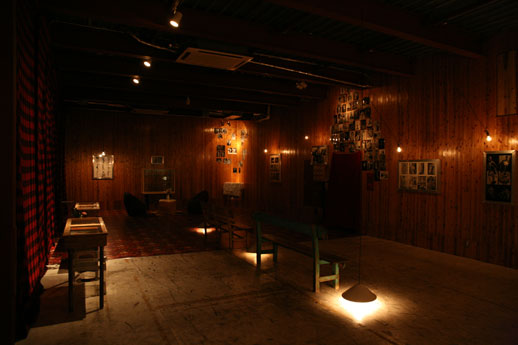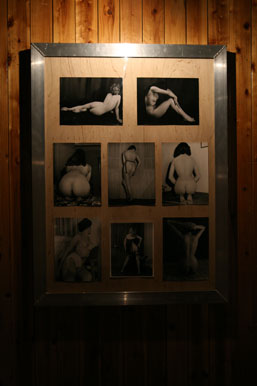Burlesque Lovelies of a Time Gone By
Entering the doors of Vacant in urahara (backstreet Harajuku for those in the know), you are met with a rather Scandinavian room of pine floors and walls, filled with painfully hip t-shirts designed by Sonic Youth, and a celebration of photocopiers in the form of dozens of ‘zines. Life-size doll pillows are hung on one wall, and a large pine table and bar separate you from the small photography exhibition at the back.
The immense door on the right slides sideways to reveal a wide staircase with an ominously flickering lamp. Suddenly, the mood changes from Swedish to smoky Parisian boudoir; in contrast to the usual startling brightness of modern art galleries, it is bathed in the soft glow of a Parisian boudoir. Fitting, considering the photographs hung on the wall were all from the magazine “Paris-Hollywood” that ran from the 1930s to the 1970s.
Peering out of the gloom were expanses of alabaster skin, crimson lips and bouffant hair; thighs draped seductively with silk suspenders and out-thrust hips. The figures are fabulous; shaped like generous Coca-cola bottles, with the kind of in-and-out curves you rarely see these days. Bar the burlesque pretenders, the models differ from their modern descendants; they have extra years, flesh, confidence, and waists that defy biological constraints (like ribs, for example).

Upon first glance, I wondered what I could possibly write about the exhibition. Naked women are a subject that photographers never seem to tire of, and the more liberal — or perhaps licentious — modern age permits a near ubiquity of the nude female form. Everything — from car advertisements to everyday newspapers- is plastered with them. A certain Yasumasu Yonehara has achieved notoriety on the Tokyo scene with his penchant for semi-clad ladies jumping around on beds (seemingly, images American Apparel has been producing for years). Porn has become so normalized that it is faithfully echoed in mainstream fashion and trends. So what more is there to say about ladies-in-the-buff?
Quite a lot, actually. At first, my male companion offered little insight. He looked slightly bored, yet bemused, at the antiquated images on display. “I’m not aroused in the slightest,” he muttered, peering curiously at their body hair and wide hips. “She looks like she’s selling soap… ” Well, sex sells; we knew that. But in comparison to the contemporary high-end glamor of gold, diamonds, knives and raw oysters that advertising is pickled in, or the low-rent perversions of porn, these photographs exuded a kind of rude health. The women laugh uproariously, squeeze their own flesh, pose and preen like they’re having a grand old time. Missing are the open, wet mouthed and narrowed eyes of the women-on-the-verge nowadays; or the quivering, prepubescent waifs that saturate the fashion industry.

We tend to think of attraction as natural and intuitive. Occasionally some admit our predilections are based on cultural norms, but we rarely admit the extent to which the media — and now the porn industry-shape our perceptions and deeply ingrained emotions of lust and revulsion. Sexual norms actually change with the seasons; historians in the future won’t list our decades according to skirt length or coat shapes, but rather the length and shape of our body hair. Looking at media of the noughties, however, they’ll find a very strange consortium of styles; from airbrushed playboy bunnies to pre-pubescent Eastern European models drenched in fear, past the perfectly proportioned advert girls to the tubbier hardcore “actresses”. It’s hard to sum up where the mainstream ends and lies, with minority interests fanning out in a broad, virtual display over the internet, where anything is permitted and everything is made. The spreads of the Paris-Hollywood magazine, however, seem to only represent a world gone by, of cherub-faced women and fuller figures. Now, we’ve got Dita von Teese, of course- but her whole appeal seems to pivot on an exploitation of old-fashioned ideals and charm, demonstrating just how out of fashion it’s become.
What next? For the idealized female form, it seems like less hair, smaller waists, longer legs and bigger breasts is the future; the bionic beauties of Akihabara, basically. When we finally break with reality and men turn to robots for their erotic kicks, I wonder if the historians will be flicking through Hustler and Playboy with purely academic glee.
Sophie Knight
Sophie Knight


